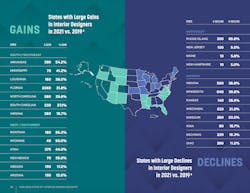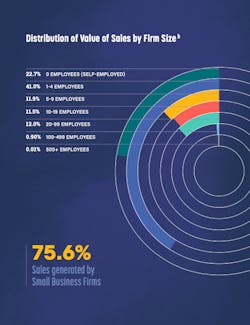ASID’s 2023 State of Interior Design Report
The American Society of Interior Designers always has a finger on the pulse of demographic and workplace trends impacting the industry, and our State of Interior Design Report is always a solid illustration of that. Let’s dive into this portrait of what 2023 has thus far and will bring to us as professionals in the months to come.
Growth in the number of interior design firms has been accelerating at a historic pace. It is estimated that this year, the total number of firms will surpass 17,500. In the past several years, there has been an increase in the number of interior designers working in interior design firms and a decline in the number of interior designers working in architecture firms. This is partially the result of new design firms being established since the beginning of the pandemic. The growing awareness of the value and importance of good interior design has made it more viable for designers to operate or work in interior design firms and provide their services directly to clients in other industries and fields.
While the states with high concentrations of interior designers and interior design firms have remained fairly constant year-to-year, a comparison of U.S. Bureau of Labor Statistics data on interior designer employment by state between 2019 and 2021 reveals that designers have been following the same trend of domestic migration, with the population moving away from the Northeast and Midwest to the South, Southwest and West. Combined, the Northeast region (excluding Connecticut, Massachusetts and New York) had 430 fewer employed designers in 2021, a 23% decline. Similarly, the Midwest region (excluding Illinois and Nebraska) lost 2,300 employed designers, a 22.5% dip.Currently, those seeking to hire interior designers are having difficulty finding available and/or qualified candidates. The number of job openings exceeds the number of interior designers seeking a job or wanting to change jobs. As a consequence, both candidates and current employees seek more compensation and a greater variety of benefits, such as remote work, even if only part of the time. Notably, women leaders are switching jobs at a greater rate, seeking more flexibility and an affiliation with companies with strong commitments to employee wellbeing as well as diversity, equity and inclusion.
Salaries for interior designers who are NCIDQ certified generally tend to be higher than those who are not. For instance, Payscale, which compiles market data on salary and compensation for a wide range of positions, shows an average annual salary of $66,000 for interior designers who are NCIDQ certified, compared to the median salary of $60,340 for all interior designers as reported by the U.S. Bureau of Labor Statistics.
Although larger firms tend to earn higher revenues than smaller ones, small firms are the key drivers of the interior design industry, accounting for nearly two-thirds of all annual sales. However, small firms are more susceptible to shifts in the economy, leading to fluctuations in earnings from year to year. Presently, most economists are forecasting that any potential recession in 2023 and/or 2024 is likely to be minor and short-lived, at least in the U.S. The interior design industry as a whole would probably experience a decline in demand in most practice sectors, but it would not be anything like the widespread retrenchment that occurred as a result of the Great Recession. Designers can mitigate the impact of a recession by ensuring access to reserves or lines of credit to manage fluctuations in cash flow, curtailing expenses, delaying new hires and large purchases, and diversifying their menu of services to suit smaller budgets.Lastly, stress among workers has reached an all-time high, and workplaces are being re-designed. The labor shortage has provided new opportunities for persons with neurodivergent conditions. To contribute fully and be productive, they require workspaces with appropriate modifications and interventions not usually available to most employees. Additionally, older adults are choosing to “rewire” rather than retire, with some retirees returning to work full-time. Workplaces are being adjusted to provide a variety of adaptable workspaces and a greater degree of individual control over the work environment in order to support a multigenerational workforce. And given that many are requiring employees to return to the office, companies are remodeling offices to support hybrid work arrangements, creating diversity in the types of spaces needed to support different types of work. These environments include deep focus spaces for quiet work, “soulful” spaces with comfortable and creative furniture and conversation nooks, innovation or event spaces, formal gathering spaces and community spaces. They have been shown to help break down silos and encourage greater collaboration and interpersonal encounters.


